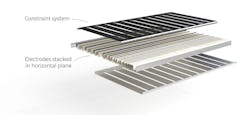U.S. battery manufacturer Enovix (Fremont, CA) recently announced a collaboration with IPG Photonics (Oxford, MA) to promote the transition from mechanical cutting to laser processing across the industry as next-generation laser tooling equipment can significantly advance efforts to scale production.
“Our manufacturing process has advanced significantly going from 30 W lasers in 2018 to 1 kW lasers today, which will be incorporated into the Gen2 systems,” said Ashok Lahiri, co-founder and CTO of Enovix. The firm has built a reputation for its design and manufacture of next-generation 3D silicon lithium-ion batteries (see Fig. 1). “Our process relies heavily on the unique capabilities and precision of laser patterning technology. Leveraging both industry gains in laser power, as well as proprietary advances in electrode processing techniques, over the last 15 months, Enovix has demonstrated a severalfold improvement in laser throughput in high-volume production.”
New architecture
Enovix has developed a novel technology with the potential to revolutionize battery manufacturing with the way it processes electrodes (see Fig. 2). When looking at a traditional electric battery, it doesn’t matter if the manufacturer uses a jelly roll or stack approach since electrodes are stacked in the vertical direction. Enovix turns the stack by 90 degrees so that the stacking direction is horizontal, changing the orientation of the electrodes (see Fig. 3). “This means you’re traditionally cutting XY dimensions. We are cutting electrodes in the X-Z dimension—and that’s fairly short,” he says. “We have a lot more edge to cut, and precision is crucial, especially in large batteries where the thickness of the cell is 20 or 30 mm. This limits the use of a mechanical system where precision levels are in the order of millimeters. You really need micron-level precision, which lasers supply.”With larger battery cells, manufacturers are moving towards stacking large sheets on top of each other rather than using the jelly roll approach. With this, there is a drive to move away from mechanical towards laser processing. The reasoning is simple: lasers are more precise when addressing complex geometries. “Laser processing is currently a more expensive avenue, yet the performance improvements in laser processing are narrowing the gap with mechanical approaches—approaches that are not really changing or evolving,” says Lahiri. “And if there is a crossover point, obvious gains exist when you can do cuts with more precision.”
As the architecture has evolved, Enovix has incorporating a massive increase in power and although not necessarily linear, the cutting rate is largely linked to the increase in power. “Whether we use pulsed or continuous-wave, these are meaningful characteristics we essentially develop internally. We take laser systems from IPG and others and incorporate them into these operations, allowing us to be very precise and very fast,” says Lahiri. “We’re trailblazing the use of lasers and providing solutions that could be more widely adapted for the battery. And what’s in it for us is access to their R&D roadmap to help guide us so we can adopt those innovations.”
When transitioning, manufacturers need to understand how to manage thermal properties using laser processing. After all, it’s quite different from mechanical systems. “Although you can still get degrees, you don’t necessarily get transformation of materials,” he says. “The geometric properties of that degree are different as well. These are manageable aspects, but you have to develop processes and design to tolerate process changes.”
Transformative times
Laser advancement around the type of source from nanosecond pulsed laser, femtosecond laser, continuous-wave laser, or something in between is constantly evolving. The result is a race between different approaches. “You need to engineer and optimize systems to achieve the best result per kilowatt hour of energy that you can produce,” says Lahiri. “When working to enable this kind of electrified future, the cost of energy storage remains a big concern, so anything that can be done to improve the process could be a game-changer.”
Recognizing the opportunity, Enovix has been on a journey to build a scalable architecture to enable high-volume manufacturing. “There’s a huge call for better batteries to meet the growing demand and address consumer concerns. We would like to really transform this industry first, and then use that as leverage to get into other industries,” he says. “What’s unique about our batteries is that our architecture allows us to replace graphite to one that uses silica and enjoy underplaying what we call 100% active.”

Peter Fretty | Market Leader, Digital Infrastructure
Peter Fretty began his role as the Market Leader, Digital Infrastructure in September 2024. He also serves as Group Editorial Director for Laser Focus World and Vision Systems Design, and previously served as Editor in Chief of Laser Focus World from October 2021 to June 2023. Prior to that, he was Technology Editor for IndustryWeek for two years.
As a highly experienced journalist, he has regularly covered advances in manufacturing, information technology, and software. He has written thousands of feature articles, cover stories, and white papers for an assortment of trade journals, business publications, and consumer magazines.


